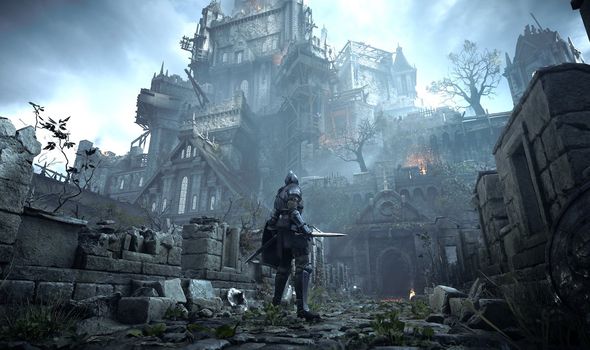PlayStation 5 is an exciting next-gen console (Image: GETTY)
After making us wait for what seemed like an eternity, Sony has finally unleashed its next-gen PS5 console.
And it’s good news for anybody lucky enough to secure a PlayStation 5 at launch, because Sony’s new machine is one seriously big upgrade… quite literally.
There are two different PS5 models available at launch, although the differences are much more straightforward compared to the Xbox Series X and Series S.
PlayStation 5 customers can pick up the new console with an Ultra-HD optical disc drive for £450/$499 (this is the one I’ll be reviewing), or without a disc drive for £360/$399.
There are no differences when it comes to how the games look and play, just that the cheaper model doesn’t take discs. This means you’ll have to buy games directly from the PlayStation Store and download them to the console.
The disc-free model is also lighter than its more expensive counterpart, although at around 4kg, it’s still one of the biggest and bulkiest gaming machines around.
Of course, this pales in comparison to the model with the disc-drive, which weighs in at just under a stone with the base attached. If the Xbox Series X looks like a fridge, then the PS5 looks like it ate everything in it.
I think the inevitable PS5 Slim update will be a popular choice with fans, because the gargantuan PlayStation 5 launch model is just plain ugly. At least it’s versatile enough to be stood up or laid flat, which means you’ve got a better chance of hiding it from sight.
On the plus side, the PS5 console is extremely quiet, and in my experiences at least, doesn’t seem to generate much heat, especially compared to the Xbox Series X.
Indeed, minus a few minor quibbles with the user-interface and whatnot, there’s very little else to dislike about the PS5.
Unlike Microsoft’s ‘one ecosystem to bind us all’ approach, the PS5 feels like a true next-gen upgrade, where everything has been redesigned and revamped.
This includes the slick new home screen, which doesn’t just look fantastic, but is quick and easy to navigate.
The main home screen displays a selection of your most recently played games, complete with high resolution background images and separate music for each individual title.
Game tabs are bookended by the Library icon and PlayStation Store, the latter of which being fully integrated into your home screen for even speedier navigation.
If I was being really picky, I would like more dashboard customisation options and game folders, but other than that, I really like the user-interface. It’s smooth, stylish and feels well put together.
This speed and smoothness likely has something to do with the console’s solid state drive (SSD), which makes everything run that little bit faster.
The benefits of the solid state drive are clear to see when you fire up a game and don’t have to wait minutes for it to load.
Fortnite, for example, takes around 30 seconds to get from the PS5 dashboard to the game lobby. This is something that would have taken a good couple of minutes in the first iteration of the PS4.
Then there are games like Demon’s Souls, where you die and restart in next to no time at all. This is a pretty big deal in a game where you’ll die a lot – remember how annoying this was in Bloodborne?
Loading times in older games vary from title to title, with fast travel and restarts taking anywhere between 5-10 seconds in games like Ghost of Tsushima, Days Gone and Tony Hawk’s Pro Skater 1+2.
Not only do the games run faster, but they also perform much better. Indeed, once you start playing games at a consistent 60 frames-per-second, it’s hard to go back to anything less. I found this when flitting between performance and resolution modes in Godfall, where performance wins all day long.
Needless to say, PS5 games look better than ever before, featuring increased draw distances, more detail, improved lighting and generally much higher resolutions.

Demon’s Souls looks incredible on the PS5 (Image: SONY)
A good example of this is Demon’s Souls, where the clarity in distant buildings and mountains is unbelievable. Character models and environmental details aren’t bad either.
Even something like Fortnite looks a lot better on PS5, with massively improved textures, water effects and draw distances that better showcase the map.
With support for ray-tracing technology, PS5 games will also feature more realistic lighting and reflections. This is especially evident with all the skyscrapers in Spider-Man Miles Morales, or the puddles in Devil May Cry 5: Special Edition.
If you’ve ever thought about investing in a top-of-the-range TV, now is the time.
As you can probably tell from the games I’ve mentioned already, the PS5 launch line-up is pretty special, especially if you include backwards compatible games available as part of the PlayStation Plus Collection.
Demon’s Souls is my favourite of the bunch, but I’ve also enjoyed my time with Godfall, Spider-Man: Miles Morales, Sackboy: A Big Adventure and the absolutely sublime Astro’s Playroom.
Seriously, not since Wii Sports has a game done a better job of showcasing a new console than Astro’s Playroom.
This delightful 3D platform game – which is free with the console – is basically a demo for the game-changing DualSense controller.
From a design standpoint, Sony’s new controller isn’t too disimilar to its PS4 predecessor, featuring the same layout as before. It’s slightly bigger and heavier, but not enough to make it any less comfortable – unless you’ve got really small hands.
Aside from the white and black colour scheme, the biggest differences aren’t what you see, but rather what you feel.
The controller’s advanced haptic feedback technology means that if your character is skating on ice, for example, you can actually feel it through the controller. Ditto for blasts of wind, rain, sand, snow, hail, grass and pretty much everything else you can think of. It’s quite literally sensational.
Adaptive triggers also play an important role in creating immersion, with varying levels of resistance based on your actions. In Astro’s Playroom, the level of resistance increases when you’re pulling back on a bow.

Astro’s Playroom skating on ice (Image: SONY)

Astro’s Playroom with DualSense controller (Image: SONY)
Where I see adaptive triggers being more divisive is in multiplayer shooters like Fortnite, where increased trigger resistance may put you at a disadvantage.
I think the increased resistance coupled with the haptic feedback makes shotguns and pistols feel weightier and deadlier – and as a result, more satisfying – but it does feel slightly slower.
Fortunately, most games let you customise your controller settings, so it’s largely a non-issue. It may even be one of perception rather than an actual reduction in firing speed.
Based on my time with Astro’s Playroom, I think the DualSense is the most exciting thing about the PS5, and I can’t wait to see how upcoming games utilise the controller. Weapon jamming in Deathloop sounds really cool, and hunting in Horizon Zero Dawn 2 should be fantastic.
I’ve also read conflicting reports about the DualSense battery life, which in my experience – playing a combination of new and backwards compatible games – runs for 7-8 hours. No complaints from me.
Indeed, the only real complaint I’ve got about the next-gen PlayStation is the way it looks, and I’m not exactly in a position to criticise something for being ugly.
From the launch line-up to the loading times, DualSense to the dashboard, the PS5 is a fresh and exciting new console that truly feels like a next-gen device.
VERDICT: 5/5




